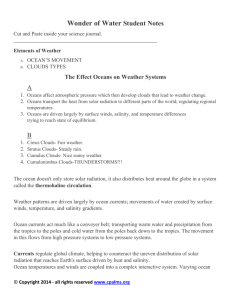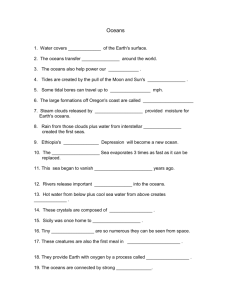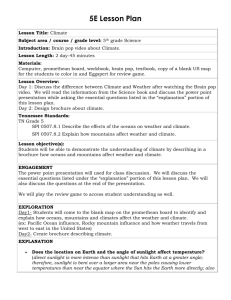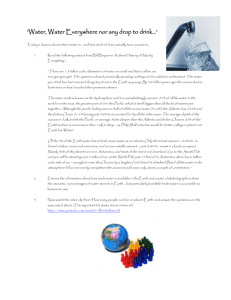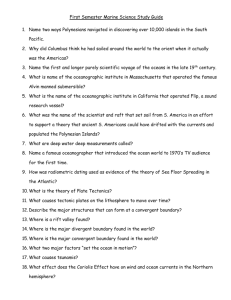Chapter 3 Review – The Hydrosphere / Biosphere – Page 73
advertisement
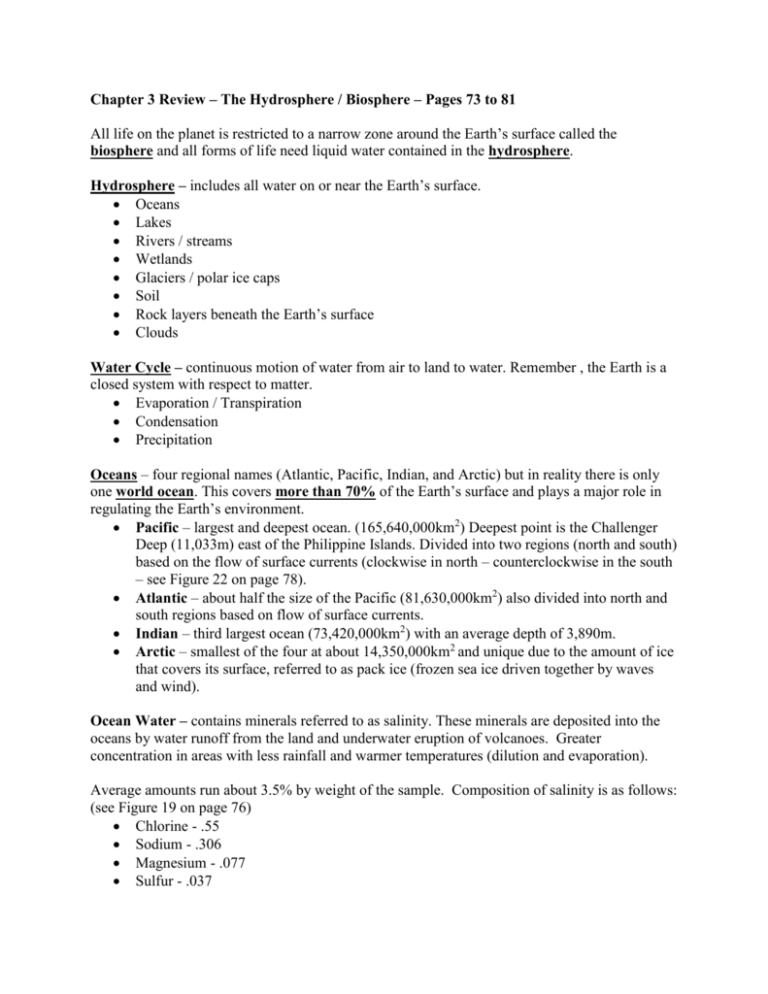
Chapter 3 Review – The Hydrosphere / Biosphere – Pages 73 to 81 All life on the planet is restricted to a narrow zone around the Earth’s surface called the biosphere and all forms of life need liquid water contained in the hydrosphere. Hydrosphere – includes all water on or near the Earth’s surface. Oceans Lakes Rivers / streams Wetlands Glaciers / polar ice caps Soil Rock layers beneath the Earth’s surface Clouds Water Cycle – continuous motion of water from air to land to water. Remember , the Earth is a closed system with respect to matter. Evaporation / Transpiration Condensation Precipitation Oceans – four regional names (Atlantic, Pacific, Indian, and Arctic) but in reality there is only one world ocean. This covers more than 70% of the Earth’s surface and plays a major role in regulating the Earth’s environment. Pacific – largest and deepest ocean. (165,640,000km2) Deepest point is the Challenger Deep (11,033m) east of the Philippine Islands. Divided into two regions (north and south) based on the flow of surface currents (clockwise in north – counterclockwise in the south – see Figure 22 on page 78). Atlantic – about half the size of the Pacific (81,630,000km2) also divided into north and south regions based on flow of surface currents. Indian – third largest ocean (73,420,000km2) with an average depth of 3,890m. Arctic – smallest of the four at about 14,350,000km2 and unique due to the amount of ice that covers its surface, referred to as pack ice (frozen sea ice driven together by waves and wind). Ocean Water – contains minerals referred to as salinity. These minerals are deposited into the oceans by water runoff from the land and underwater eruption of volcanoes. Greater concentration in areas with less rainfall and warmer temperatures (dilution and evaporation). Average amounts run about 3.5% by weight of the sample. Composition of salinity is as follows: (see Figure 19 on page 76) Chlorine - .55 Sodium - .306 Magnesium - .077 Sulfur - .037 Calcium - .012 Potassium - .011 Others - .007 Ocean Temperature Zones – grouped into three major divisions (see Figure 20 on page 76) Surface Zone – 0 to 300 m (can extend to 350 m with waves and currents) temperatures are fairly consistent. Thermocline – 300 to 700 m – temperatures drop rapidly in this zone due to diminished sunlight Deep Zone – 700 to 1200 m – temperature drop slows in this zone due to tremendous pressures. Oceans as Global Temperature Regulators – one of the most important functions of the “world ocean” is to absorb and store energy from sunlight. The world oceans absorb more than half of the solar radiation that reaches the planet’s surface. Surface currents can influence the climate of the land areas they flow past. Deep currents are stream-like movements of water that flow very slowly along the floor of the oceans. Currents move clockwise in the northern hemisphere and counter-clockwise in the southern hemisphere. Fresh Water - only 3% of the Earth’s water is classified as “fresh” and of this, much is locked up in icecaps and glaciers. The rest is found in rivers, lakes, wetlands, the soil, rock layers below the surface and the atmosphere. River systems – network of streams that drain an area of land. Tributaries – smaller streams or rivers that flow into larger ones. Groundwater – water that drains down into rock layers beneath the surface of the Earth. This accounts for less than 1% of all water on Earth! Aquifer – rock layer that stores and allows the flow of groundwater. Recharge Zone – surface of land where water enter an aquifer. Biosphere - the narrow zone (11km into the ocean and 9 km into the atmosphere) where life can exist. Life exists on Earth because of liquid water, temperatures between 10o C and 40o C and a source of energy (sunlight). Closed System – energy enters the environment but matter does not. Sunlight energy is allowed in to supply necessary fuel for plants and food webs and chains. Open System – matter and energy allowed to transfer in. Early history of Earth allowed matter in as a result of comet and meteorite collisions.

